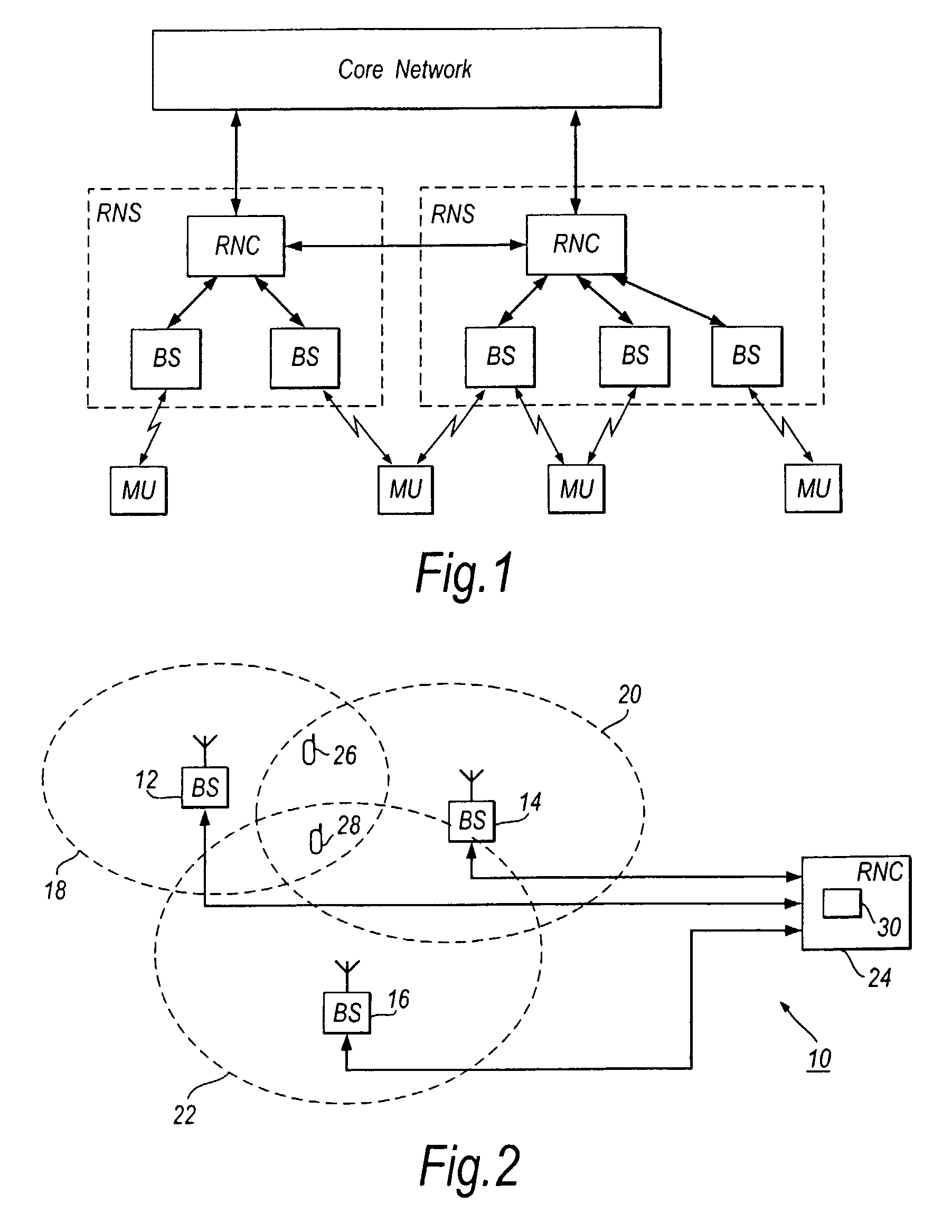Cell selection
- Summary
- Abstract
- Description
- Claims
- Application Information
AI Technical Summary
Benefits of technology
Problems solved by technology
Method used
Image
Examples
first embodiment
2. First Embodiment
[0081]In a first embodiment of the invention, the FCSS technique described above is modified such that the selection of a cell for data transmission is based at least partially on the amount of congestion in the active cells. In this embodiment, each base station broadcasts at regular intervals (e.g. every radio frame) its congestion level for the next one or more radio frames. The mobile unit receives these broadcast messages, and whenever the difference in signal qualities between two cells is below a certain threshold, the mobile unit selects the cell with the lowest congestion.
[0082]The present embodiment stems from the recognition that, if one active cell is more lightly loaded than another active cell, then in certain circumstances it might actually be preferable to use the more lightly loaded cell even if the signal quality in that cell is not as good as in the other cell.
[0083]Parts of a base station in the first embodiment for transmitting signals to a mo...
second embodiment
3. Second Embodiment
[0118]In a second embodiment of the invention, the FCSS technique described above is again modified such that the selection of a cell for data transmission is based at least partially on the amount of congestion in the active cells. However, in the second embodiment, the mobile unit itself measures cell congestion levels.
[0119]In the second embodiment, shared transmission channels are used for transmitting data from base stations to several mobile units. A mobile unit which is in a soft handover region monitors the shared transmission channels from the active base stations to obtain measures of the cell congestion levels. Whenever the difference in signal qualities between two cells is below a certain threshold, the mobile unit selects the cell with the lowest congestion.
[0120]Parts of a base station in the second embodiment for transmitting signals to a mobile unit are shown in FIG. 5. The base station 120 comprises data buffers 122, 122′, 122″, multiplexer 128,...
third embodiment
4. Third Embodiment
[0131]In a third embodiment of the invention, the FCSS technique described above is used to select a cell for data transmission, and in addition the congestion level in the cell is measured by the base station. If the selected cell is too congested the base station does not transmit data to a particular mobile unit, even if the mobile unit has selected the base station for data transmission. The base station may wait until its cell is less congested to transmit the data packets, or the data packets may be transmitted by another base station.
[0132]Parts of a base station in the third embodiment for transmitting signals to a mobile unit are shown in FIG. 7. The base station 200 comprises data buffer 202, congestion level measurement unit (CLMU) 204, multiplexers 205, 205′, 205″, spreader 206, combiner 208, transmitter 210, duplexer 212, antenna 214, receiver 216, despreader 218, demultiplexer 220 and controller 222.
[0133]In operation, data packets for transmission t...
PUM
 Login to View More
Login to View More Abstract
Description
Claims
Application Information
 Login to View More
Login to View More - R&D
- Intellectual Property
- Life Sciences
- Materials
- Tech Scout
- Unparalleled Data Quality
- Higher Quality Content
- 60% Fewer Hallucinations
Browse by: Latest US Patents, China's latest patents, Technical Efficacy Thesaurus, Application Domain, Technology Topic, Popular Technical Reports.
© 2025 PatSnap. All rights reserved.Legal|Privacy policy|Modern Slavery Act Transparency Statement|Sitemap|About US| Contact US: help@patsnap.com



